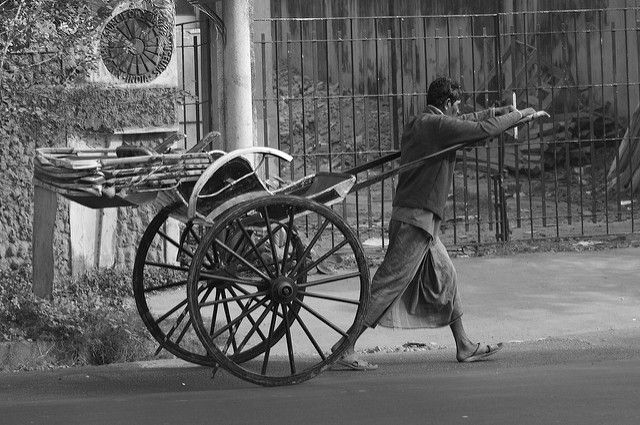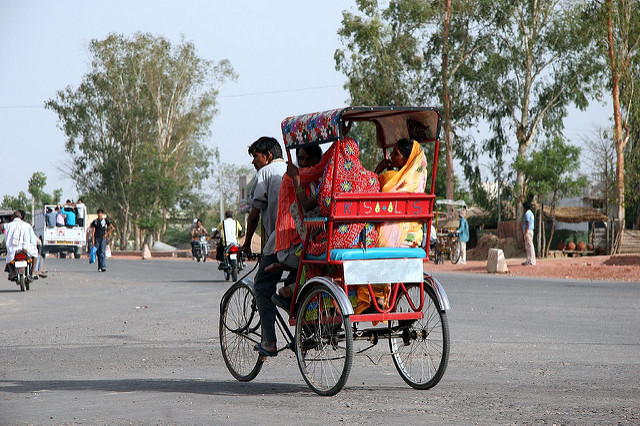The Ins and Outs of Rickshaws Posted by Rachael on Apr 30, 2018 in Uncategorized
As an American visiting India for the first time, I did not come equipped, as you might expect, with the “sixth sense” of being able to bargain (bargain=मोल तोल करना/mol tol karnaa) fluently. This was a particular handicap when I was seeking transportation, specifically in the form of rickshaws and auto rickshaws. For Americans (अमेरिकन लोग/वाले/amerikan log/vaale), to whom bargaining seems like a mysterious art form that they can never hope to master (and such a hope, I must say, is futile), I have a few anecdotes (कहानियाँ/kahaaniyaan, fem. noun) and tips (सलाह/salaah, fem. noun) to aid you along the way.
Rickshaws
(or रिक्शेवाले, also known by the abbreviated name, “ऑटो”)
Rickshaws can be tricky. And, if you look at all Northern European and/or are not ethnically ambiguous, they will be trickier. Almost all of my friends who looked even somewhat Indian (yes, some Hispanic and Latino people and even some African Americans will be mistaken for Indian or somehow accepted as such and thus addressed familiarly as दीदी/sister and भाई/brother) got fair prices (किराया/kiraayaa, masc. noun=”rate” rather than दाम/daam, masc. noun=”price”) or at least not grossly inflated ones. But, if you’re wearing SPF 100, you’re in trouble from more than just the sun. Rickshaw drivers (रिक्शा चलानेवाला/ड्राइवर/rickshaw chalaanevaala/driver) will see you from a mile away (and not just because you glow in the dark and are eerily luminous in the day) and either refuse to drive you, as sometimes happens, or, more likely, will target you specifically as a way to make extra cash fast. I can’t say I blame them, really. If you’re from a rich nation like the United States, even if you are not rich (अमीर/amir) yourself, people will try to charge you more, reasoning that you can easily afford it with those bathtubs full of cash that you’re wallowing in daily. And, unfortunately, ignorant people still make the assumption that white=American or, in some cases, European, although Americans and Europeans are as diverse as could be.
In a new city (नया शहर/nayaa sheher, masc.) especially, when you do not know your way around, the first couple of days you WILL end up paying substantially more, sometimes twice or three times the normal price. This is fine if you’re a short-term tourist with some cash to spare. But, if you’re planning on staying in a place longer and you want to get a feel for how regular life is supposed to be, you need to learn your way around, either by studying a map (out of sight of aforementioned rickshaw drivers, of course), by walking around the city, taking the local bus (बस/bus, fem.) and riding it from its first to final stop and/or by trying out a cycle rickshaw (साइकिल रिक्शा). Cycle rickshaws are becoming increasingly less common, especially in large metropolitan areas, but they can still be found and are much cheaper (सस्ता/sastaa) than their automatic cousins. They are also a good way to feel the breeze (however subtle) in your hair and really appreciate your surroundings (पास-पड़ोस/paas paros, masc.), especially so that you can begin recognizing landmarks.
Street addresses (पता/pataa, masc.) in India often do not have clearcut clues with a number, the street and a zip or pin code, (and, even if they do), most people identify places by landmarks, such as businesses close by, a particularly notable statue, a park, a mall, etc. Once you learn your way around, even if you haven’t gotten down the specifics yet, be confident––that is, fake it till you make it. 95% of rickshaw drivers will try to charge you twice or three times the price initially, so it’s up to you to show them that you are not an ignorant firangi/foreigner (फ़िरंगी या/or विदेशी/videshi) and know the ratio between distance (दूरी/doori, fem.) and rate. Another tip is that, unless you are in a metropolitan area such as Delhi or Bangalore, the meters on rickshaws are just there for show––they either do not work or have been rigged to record a different price than you are ready to pay. Even if a rickshaw driver says that a meter is working, be suspicious and insist on a price ahead of time rather than waiting until the end of the ride to see what the “trusty” meter says.
And, as has happened to me many times, if a rickshaw driver demands (माँगना/magnaa) a different price than what you had originally agreed upon, have your change (छुट्टा/chuttaa, masc.) READY (do not depend on a rickshaw driver’s mercy to provide you with change, not just because some of them won’t give it, actually most of them do, but the issue is that they may not even have change for you; get all ten rupee notes from a bank if you have to), hand it over and get out of there (before it gets ugly).
Another tip from someone who’s been there––if, especially at night, you encounter a rickshaw driver who tries to charge you three times the price or some other ridiculous rate and even if you negotiate it down (be aware, this is difficult to do at night; some drivers will charge double or triple the rate as a standard fare at night), he may still respond in a negative way, especially at the end of the ride. What’s best in these situations, even if you manage to negotiate the fare down, is just to walk away before taking the ride––you don’t really know what can happen, and your safety is more important than a couple of bucks saved. One of the ways a driver can “respond negatively” is by harassment (छेड़-छाड़ करना/cher char karnaa). A common way of trying to harass a woman is by attempting the “American handshake.” Shaking a woman’s hand, especially a foreign woman, is perhaps seen as acceptable as this is what Americans do all the time but, for right now, you’re not in America and you do not have to accept someone’s handshake. Rather than seeing this through an American lens of “being friendly” and a “normal gesture of greeting,” you should see it through the lens of the culture in which you now find yourself: “It’s not acceptable for a random man outside your social or work circle to extend a hand to you, especially if you’re alone or it’s nighttime.” Many times the “handshake” move has been tried on me and, let me tell you, it wasn’t a gesture of greeting. This is unacceptable behavior and you should not have to tolerate it; my advice is, if a random person tries to extend a hand to you, respond with a traditional greeting (“नमस्ते/namaste” या/or “नमस्कार/namaskaar”) and press your palms together, showing deference to conservative norms between sexes, the culture that you now find yourself in and the other person’s desire to greet you in one fell swoop. Sure, this may seem overly formal but, if you’d rather not touch a stranger (अजनबी/ajnabi), it’s probably your best option.
Lastly, just assume during the day that most rickshaw drivers you encounter will attempt to charge you double the price (दोगुना किराया/dogunaa kiraayaa) initially but, if you state confidently, “मैं आपको __ (amount) से ज़्यादा नहीं दूँगा/दूँगी,” “यहाँ पे रहता/रहती हूँ, मैं जानता/जानती हूँ कि इतनी दूर नहीं है/मैं जानता/जानती हूँ कि आप बहुत ज़्यादा माँग रहे हैं”––you can wear the driver down until he agrees or, you can walk off until he follows you, requesting your business (this usually works). Once in the rickshaw, feel out the situation––does the driver seem relaxed, friendly and ready to chat or does he seem to prefer his own company (using the pronoun “he” and “his” here is not an accident as all of the rickshaw drivers I encountered in North India were male, although you can find women drivers more prevalently in South India). If the former is true, try to engage him in conversation (बातचीत/baatchit, fem.)––you’ll be pleasantly surprised that many people will open up quite readily, especially if you speak to them in Hindi. Unlike learning other languages where native speakers constantly correct your grammar and/or pronunciation, Hindi speakers are incredibly tolerant and do not bat an eyelash at mistakes, often because they’re not perceived as mistakes. Be aware that Hindi may not be your driver’s first language either; he may be more familiar with Marwari, Bengali, Awadhi, Bhojpuri, etc. If you strike up a conversation and found that you’ve made a new friend (दोस्त/dost), you could request the driver’s card and/or mobile number so that you can text him the next time you need a ride, which is preferable to riding with a revolving door of strangers every day. Additionally, ride-sharing rickshaws, that look a bit like miniature cars, are becoming more popular so, if you want to ride on the cheap and don’t mind getting your knees squished, you could give it a try.
Of course, Uber is now fairly popular in India, despite all of the scandals. If you feel more comfortable with that, by all means use it. You may miss some experiences that can only be had in rickshaws, though, if you choose Uber or a car service instead. However, I recommend hiring a car and driver for longer trips across state lines or on day trips to faraway places. Better yet, if you’re staying in a reputable hotel, you can ask the staff to hook you up with a car and driver on recommendation and, that way, you’ll be more certain that your driver will be both reliable and skilled.
On a parting note––try a cycle rickshaw at least once, you won’t be sorry 🙂

Build vocabulary, practice pronunciation, and more with Transparent Language Online. Available anytime, anywhere, on any device.







Comments:
AM:
Hi Rachel,
I enjoy every single post you write. I also studied Hindi in India, but unfortunately my experience wasn’t that good. I found the institution quite bad.
Would be possible to tell the name of that program in Jaipur? If you want you can use my email.
Thank you.